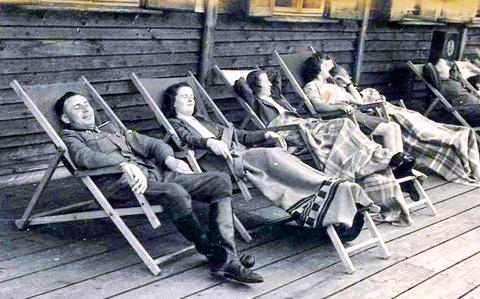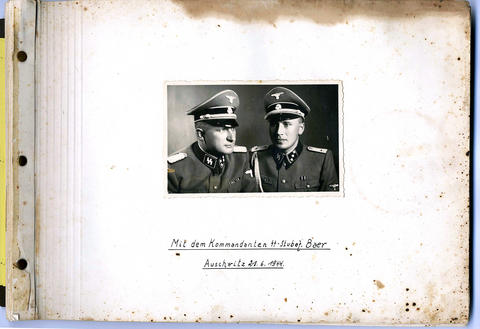Last December, Rebecca Erbelding, a young archivist at the US Holocaust Memorial Museum, opened a letter from a former US Army intelligence officer who said he wanted to donate photographs of Auschwitz he had found more than 60 years ago in Germany.
Erbelding was intrigued: Although Auschwitz may be the most notorious of the Nazi death camps, there are only a small number of known photos of the place before its liberation in 1945. Some time the next month, the museum received a package containing 16 cardboard pages, with photos pasted on both sides, and their significance quickly became apparent.
As Erbelding and other archivists reviewed the album, they realized they had a scrapbook of sorts of the lives of Auschwitz's senior SS officers that was maintained by Karl Hocker, the adjutant to the camp commandant. Rather than showing the men performing their death camp duties, the photos depicted, among other things, a horde of SS men singing cheerily to the accompaniment of an accordionist, Hocker lighting the camp's Christmas tree, a cadre of young SS women frolicking and officers relaxing, some with tunics shed, for a smoking break.

Photo: NY Times News Service
In all there are 116 pictures, beginning with a photo from June 21, 1944, of Hocker and the commandant of the camp, Richard Baer, both in full SS regalia. The album also contains eight photos of Josef Mengele, the camp doctor notorious for participating in the selections of arriving prisoners and bizarre and cruel medical experiments. These are the first authenticated pictures of Mengele at Auschwitz, officials at the Holocaust museum said.
The photos provide a stunning counterpoint to what up until now has been the only major source of preliberation Auschwitz photos, the so-called Auschwitz Album, a compilation of pictures taken by SS photographers in the spring of 1944 and discovered by a survivor in another camp. Those photos depict the arrival at the camp of a transport of Hungarian Jews, who at the time made up the last remaining sizable Jewish community in Europe. The Auschwitz Album, owned by Yad Vashem, the Israeli Holocaust museum, depicts the railside selection process at Birkenau, the area where trains arrived at the camp, as SS men herded new prisoners into lines.
The comparisons between the albums are both poignant and obvious, as they juxtapose the comfortable daily lives of the guards with the horrific reality within the camp, where thousands were starving and 1.1 million died.

Photo: NY Times News Service
For example, one of the Hocker pictures, shot on July 22, 1944, shows a group of cheerful young women who worked as SS communications specialists eating bowls of fresh blueberries. One turns her bowl upside down and makes a mock frown because she has finished her portion.
On that day, said Judith Cohen, a historian at the Holocaust museum in Washington, 150 new prisoners arrived at the Birkenau site. Of that group, 21 men and 12 women were selected for work, the rest transported immediately to the gas chambers.
Those killings were part of the final frenetic efforts of the Nazis to eliminate the Jews of Europe and others deemed undesirable as the war neared its end. That summer the crematoriums broke down from overuse and some bodies had to be burned in open pits. A separate but small group of known preliberation photos were taken clandestinely of those burnings.

Photo: NY Times News Service
Auschwitz was abandoned and evacuated on Jan. 18, 1945, and liberated by Soviet forces on Jan. 27. Many of the Hocker photos were taken at Solahutte, an Alpine-style recreation lodge the SS used on the far reaches of the camp complex alongside the Sola River.
Though they as yet have no plans to exhibit the Hocker album photos, curators at the Holocaust Memorial Museum have created an online display of them on the museum's Web site (ushmm.org) that will be available this week. In many cases they have contrasted the Hocker images with those from the Auschwitz Album. In one, SS women alight from a bus at Solahutte for a day of recreation; meanwhile, in a picture from the Auschwitz Album taken at about the same time, haggard and travel-weary women and children get off a cattle car at the camp.
Museum curators have avoided describing the album as something like "monsters at play" or "killers at their leisure." Cohen said the photos were instructive in that they showed the murderers were, in some sense, people who also behaved as ordinary human beings. "In their self-image, they were good men, good comrades, even civilized," she said.
Sarah Bloomfield, the museum's director, said she believed that other undiscovered caches of photos or documents concerning the Holocaust existed in attics and might soon be lost to history.
The donor, who had asked to remain anonymous, was in his 90s when he contacted the museum, and he died this summer. He told the museum's curators that he found the photo album in a Frankfurt, Germany, apartment where he lived in 1946.
The photos of the Auschwitz Album were discovered by Lili Jacob, a Hungarian Jew who was deported in May 1944 to Auschwitz, near Krakow in Poland. She was transferred to another camp, Dora-Mittelbau in Germany, where she discovered the pictures in a bedside table in an abandoned SS barracks.
She was stunned to recognize pictures of herself, her rabbi and her brothers ages 9 and 11, both of whom she later discovered had been gassed immediately after arrival.
Hocker fled Auschwitz before the camp's liberation. When he was captured by the British he was carrying false documents identifying him as a combat soldier. After the 1961 trial of Adolf Eichmann in Israel, West German authorities tracked down Hocker in Engershausen, his hometown, where he was working as a bank official.
He was convicted of war crimes and served seven years before his release in 1970, after which he was rehired by the bank. Hocker died in 2000 at 89.

June 9 to June 15 A photo of two men riding trendy high-wheel Penny-Farthing bicycles past a Qing Dynasty gate aptly captures the essence of Taipei in 1897 — a newly colonized city on the cusp of great change. The Japanese began making significant modifications to the cityscape in 1899, tearing down Qing-era structures, widening boulevards and installing Western-style infrastructure and buildings. The photographer, Minosuke Imamura, only spent a year in Taiwan as a cartographer for the governor-general’s office, but he left behind a treasure trove of 130 images showing life at the onset of Japanese rule, spanning July 1897 to

In an interview posted online by United Daily News (UDN) on May 26, current Chinese Nationalist Party (KMT) Chairman Eric Chu (朱立倫) was asked about Taichung Mayor Lu Shiow-yen (盧秀燕) replacing him as party chair. Though not yet officially running, by the customs of Taiwan politics, Lu has been signalling she is both running for party chair and to be the party’s 2028 presidential candidate. She told an international media outlet that she was considering a run. She also gave a speech in Keelung on national priorities and foreign affairs. For details, see the May 23 edition of this column,

The Taiwan People’s Party (TPP) on May 18 held a rally in Taichung to mark the anniversary of President William Lai’s (賴清德) inauguration on May 20. The title of the rally could be loosely translated to “May 18 recall fraudulent goods” (518退貨ㄌㄨㄚˋ!). Unlike in English, where the terms are the same, “recall” (退貨) in this context refers to product recalls due to damaged, defective or fraudulent merchandise, not the political recalls (罷免) currently dominating the headlines. I attended the rally to determine if the impression was correct that the TPP under party Chairman Huang Kuo-Chang (黃國昌) had little of a

At Computex 2025, Nvidia CEO Jensen Huang (黃仁勳) urged the government to subsidize AI. “All schools in Taiwan must integrate AI into their curricula,” he declared. A few months earlier, he said, “If I were a student today, I’d immediately start using tools like ChatGPT, Gemini Pro and Grok to learn, write and accelerate my thinking.” Huang sees the AI-bullet train leaving the station. And as one of its drivers, he’s worried about youth not getting on board — bad for their careers, and bad for his workforce. As a semiconductor supply-chain powerhouse and AI hub wannabe, Taiwan is seeing